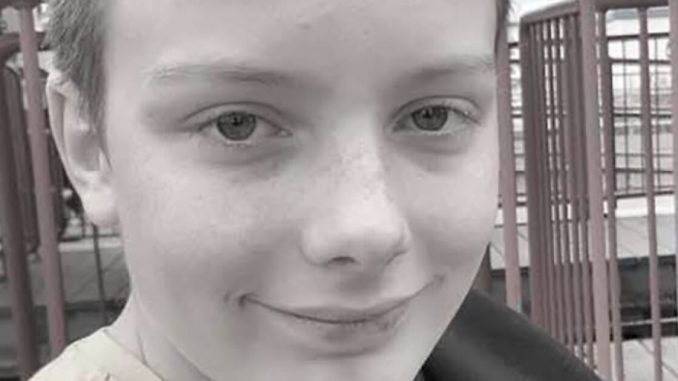
A 12-year-old boy in West Yorkshire has tragically passed away after attempting a dangerous social media stunt known as the “scarf challenge”—a fatal online trend that continues to claim the lives of children worldwide.
Sebastian, described as “a boy full of dreams, passion, and incredible talent,” was celebrating his younger brother’s First Holy Communion last Friday (June 27) at his family home in Castleford when he was found unresponsive.
“His parents gave him all the love and care in the world—but that one moment online changed everything,” a statement written by the family read.
12-year-old passed away from asphyxiation after participating in a social media “challenge”
Image credits: Daniel/Adobe Stock (Not the actual photo)
Police and ambulance service rushed to the family’s distress call and arrived at the residence on Manor Grove shortly after. Sebastian was transported to the hospital in a police-escorted convoy while first responders did everything in their power to resuscitate him.
But the damage was already done.
Image credits: GoFundMe
The tragedy has shaken West Yorkshire, with families and experts being reminded of the dangers of the digital world, where harmful content seems to be a simple click away with no regard to the age of the person on the other side of the screen.
The “challenge” in question encourages users—often children and teens—to partially asphyxiate themselves using a piece of clothing until they lose consciousness, recording and sharing the experience on social media in exchange for an adrenaline rush and the approval of their online peers.
Image credits: MadGladNat/Adobe Stock (Not the actual photo)
That same day, a fundraiser campaign was set up to help support Sebastian’s family in covering funeral expenses, psychological support, and other costs. The campaign has raised a little over £5,000 out of a goal of £9,000 at the time of writing.
“What happened is a tragedy beyond words. No parent should ever have to bury their child. No one should ever endure such heartbreak,” the side read.
“The online world can be as dangerous as the real one—sometimes even more so.”
Sebastian’s family hope his passing increases awareness of the dangers of social media
Image credits: Cavan for Adobe/Adobe Stock (Not the actual photo)
Beyond raising funds to support the family, the campaign has a more ambitious goal—making sure Sebastian is the last victim of these dangerous online trends.
“Let Sebastian’s passing not be in vain,” the campaign pleads.
“Let it be a quiet call for awareness—a reminder to stay close, to talk more, to protect the ones we love. So that other children may live. So that no other parent has to experience this unimaginable pain.”
The family then asked parents to talk with their children more often, especially about their online activity.
“Ask what they watch, who they talk to, what inspires them. Be present. Don’t assume: ‘My child would never do that.’”
The message comes as Sebastian joins a growing and deeply disturbing list of fatalities linked to asphyxiation or “blackout” challenges spreading online.
The trend has claimed the lives of at least 10 children since 2022
Image credits: Google Maps
In 2023, 16-year-old Christy Sibali passed away in France after trying the same scarf stunt.
The teenager, originally from the Democratic Republic of the Congo, was reportedly alone at home in Orléans when she attempted the challenge on May 27.
According to local reports, she had learned about the so-called “scarf game” through social media, where variations of the “blackout challenge” had been circulating under different names and methods
Image credits: Rawpixel.com/Adobe Stock (Not the actual photo)
Earlier that same year, 12-year-old Milagros Soto of Argentina also lost her life while attempting the “challenge” using a makeshift noose. As is the case with most victims, the incident was caught on camera.
Milagros had allegedly received a WhatsApp message with a link and instructions just days before. Her family believes she was manipulated and pressured into participating.
“I believe someone encouraged her to do it,” her aunt said at the time. “She was bullied a lot.”
In recent years, the dangerous trend has claimed the lives of at least seven more children, leading to four British families coming together to sue TikTok and its parent company, ByteDance, in the United States.
Earlier this year, four families sued TikTok for creating an unsafe environment for children on the platform
Image credits: Solen Feyissa/Unsplash (Not the actual photo)
The lawsuit, filed in Delaware’s Superior Court in February of this year, alleges that teenagers Isaac Kenevan, Archie Battersbee, Julian Sweeney, and Maia Walsh all passed away in 2022 after being exposed to and attempting the same deadly stunt that would later claim Sebastian’s life in 2025.
The parents accused TikTok of showing “no compassion,” and breaching its own safety policies.
“We want accountability—not just for us, but for parents around the world. TikTok needs to stop hiding. Why hold back on giving us the data? How can they sleep at night?” said one of the mothers, Lisa Kenevan.
Image credits: GoFundMe
The group alleges that TikTok refused to give them access to key information that could explain what their children saw, searched, or were exposed to before they passed away.
The lawsuit also accuses ByteDance of intentionally designing its platform to be addictive and targeting children. The complaint alleges that TikTok’s algorithm purposely “flooded” the children with an “endless stream of harms.”
TikTok, in response, has stated that it complies with data protection laws, deleting personal data unless it receives a request from law enforcement to preserve it. It also maintains that it actively blocks terms and hashtags related to “blackout challenges.”
Sebastian’s passing, however, makes one thing painfully clear: It’s not enough.
